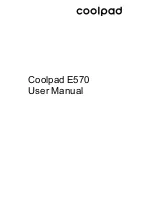
Copyright 2010-2015 Obihai Technology, Inc.
153
Unless stated otherwise, abbreviated endpoint names are case insensitive. A trunk or an endpoint is also referred to as
a
Terminal
in this document.
The following matrix shows the possible call connections between the endpoints and the trunks:
Supported endpoint calls on the OBi:
Any
Trunk
PH1
AA
Any
Trunk
n/a
yes
yes
PH
yes
no
yes
AA
yes
yes
no
Call Routing – The OBi Way
Call Routing is the process by which the OBi Device sets up a call bridge or a (endpoint) call based on such information
as: the trunk on which the call originates, the caller’s number, the called number and so on. Call Routing Rules are
parameters used to instruct the OBi device how to route calls. A call may transform into a call bridge or an endpoint call
after being routed by the OBi according to the given routing rules.
Every call has to originate from somewhere. From the device’s perspective, calls originating from the trunk side are
considered Inbound Calls, while calls originating from an endpoint are Outbound Calls. The call routing rule syntaxes for
inbound calls and outbound calls are slightly different and we shall explain them separately below. Call Routing Rule
configuration relies heavily on digit maps. If you are not familiar with how digit maps work yet, please read the
Digit
Map Configuration Section
in this document first. You can also read the
OBi-DigitMap Call Route Tutorial
document
that is available for download from www.obihai.com/docs-downloads
Inbound Call Route Configuration
Every trunk has a corresponding
InboundCallRoute
in the OBi device configuration. It is a comma separated list of
rules where each rule is also surrounded by a pair of curly brackets { }. No extra white spaces are allowed. These rules
tell the OBi how to handle an inbound call, such as sending it to the Phone (and ringing the attached phone(s)), sending
it to the Auto Attendant for further routing (interactively with the caller), or making another call on a specific trunk to
bridge with this call.
The general format is:
InboundCallRoute :=
rule
OR
{
rule
},{
rule
},….
Note that the curly braces may be omitted if there is only one rule in the route. The
OR
operator is NOT part of the
parameter syntax; it is used here to separate alternative values only.
A rule has the following format:
















































